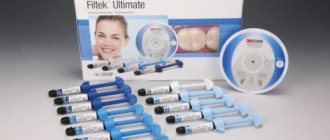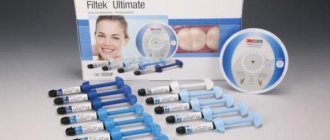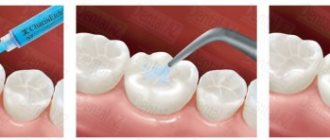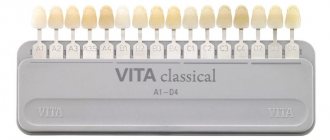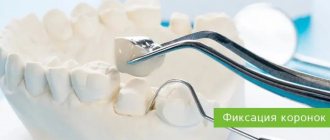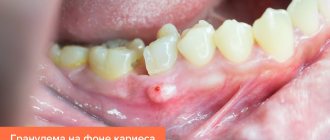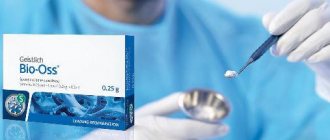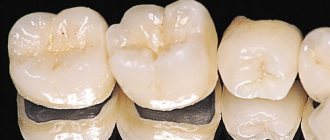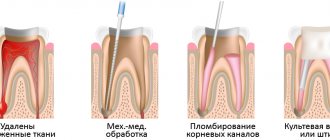Carious disease manifests itself in many cases quite unnoticed, very often having a small black dot in the tooth; when visiting the dentist, very deep caries is discovered.
Basically this confuses us and we immediately start thinking about what we should do, what material is better to use and how much it will cost us. We can answer all your questions without difficulty.
We want to tell you and offer the modern nanocomposite material Filtek. Its application is very wide, from the smallest restorations to filling large volumes of voids. In this article we will tell you about what Filtek restoration fillings are. About the areas in which they are used. We will also talk about the undoubted advantages of this light-curing material. And of course we will tell you about the different types of Filtek fillings.
What are Filtek fillings?
Filtek fillings are the word quality in the highest form of restoration materials from the American manufacturer - 3M ESPE. Similar nanocomposite materials for filling are used all over the world. With their use, it is possible to restore dental aesthetics, excellent anatomical shape and chewing function.
In what areas are Filtek materials used?
Filtek material is a nanocomposite material, its use is very extensive. Unlike many other materials, Filtek is used not only in the restoration of chewing teeth, but also in cases where it is necessary to restore the aesthetics of the front teeth. This material is universal!
Let's now list the undoubted advantages of this material!
Release form and composition
The basis of the Filtek filling material is acrylic polymer resins of various types. Each type of composite has its own specific composition , depending on the purpose of application.
To impart color to a future filling, fillers are used in the form of silicon and zirconium nanoparticles, and their combinations - nanoclusters. The sizes of these particles range from 0.6 to 20 nm.
The color of the future filling depends on the filler included in the base material. More precisely, it depends on the size and quantitative ratio of nanoparticles and nanoclusters in it. The smaller their size, the denser and more matte the filling will be.
Composite mass of various compositions, placed in syringes, is included in the package of ready-made kits for work. Depending on the goals and objectives, there are several varieties.
Single Shade Set
Single Shade is an introductory set for restoration with tones of one degree of transparency.
It consists of two 4-gram syringes with Body shades - A2 and A3, designed to restore the body of the tooth.
These types of composite have a slight degree of transparency and are used for single-color restorations.
In addition to syringes with the composite, the kit contains technical instructions for the correct use of the material.
Dual Shade Kit
This kit contains a set of 4 syringes. Available shades - 2 syringes for dentin restoration - A3, A4; 2 syringes for enamel restoration – A2, A3.
Additionally, the set contains an auxiliary scale for selecting the desired color. The kit is supplied with technical instructions.
Professional set
The professional set includes 12 syringes with different shades of the composite:
- 3 dentin colors – A2, A3 and B3;
- 4 Body shades – A2, A3, A3.5, B2;
- 4 enamel tones – A1, A2, A3, and W;
- 1 transparent shade – AT.
Along with the composite, the kit contains instructions for using the material and a special scale for determining the shade of the substance.
Filtek Z250
Available in separate 4 g syringes. It is a microhybrid material and contains an increased amount of nanoparticles. It has particularly high strength and adheres well to the walls of the tooth.
The range of applications is very wide:
- filling all types of cavities on the front and side teeth;
- performing veneers;
- splinting.
The color range of this type of composite includes 15 shades, which ensures its use in the restoration of any area of the dentition.
A filling made from Z 250 completely eliminates the possibility of recurrent caries.
Differences in composition
The composite is also based on organic resin. Unlike the Ultimate series, only bis-GMA, UDMA and bis-EMA can be found in the composition.
In addition to the matrix, the Z250 series has a different filler. It contains particles 0.5-5 microns in size.
Release form: 4 g syringe. The number of color options is much smaller; there is no division into dentin, enamel and “body”.
Differences in properties
This material also has the basic properties of composites, namely:
- satisfactory aesthetics;
- wear resistance;
- radiopacity;
- long-term preservation of the quality of the filling.
But due to the different size of the filler, the material has some disadvantages compared to the Ultimate series:
- higher shrinkage during polymerization;
- more complex application of material and its insufficient density;
- the quality of the restoration itself is lower;
- worse polishability;
- insufficient strength when used on complex and multi-level cavities.
Indications, methods of use and precautions are similar to the previous substance.
It is included in the kit
The filling material is packaged in syringes and disposable capsules.
Let's look at what the Filtek Z250 set consists of:
- 8 syringes, 4g each. A1, A2, A3, A3.5, B3, C2, D3, UD.
- Bottle with Single Bond adhesive - 2-6 ml.
- Scotchbond etching gel syringe - 3 ml.
- Trial set of Sof-Lex discs.
- Shade scale.
- Accessories.
Let's consider in what cases the use of a composite is possible.
Advantages of the material
Not every filling material has these advantages:
- The high level of density ensures excellent edge seal.
- Photopolymerizability.
- An alternative for the implementation of multi-layer restorations.
- After use, an excellent aesthetic appearance is guaranteed.
- Easy to polish.
- High level of wear resistance.
- Low shrinkage, about 2%.
- Easy to use, does not stick to tools.
- Large selection of shades.
Having such advantages, the material is very popular among dentists.
Rules for working with material
It is worth considering that Filtek Z250 contains methacrylates. There is a category of citizens who have a tendency to develop an allergic reaction to acrylic resins. It is necessary to adhere to the following recommendations when working with the material:
- Reduce exposure to the drug to reduce the risk of allergic reactions.
- Be especially careful when exposed to uncured resins.
- When working with the material, be sure to use protective gloves and non-contact equipment.
- If the filling composite gets on an unprotected area of the body, immediately wash it with running water and soap.
- Attention! Acrylates can penetrate gloves.
- If restoration material gets on the glove, it must be removed and thrown into the trash. Wash your hands thoroughly with soap. To continue working, you must wear new gloves.
- If the material gets into the eyes or other parts of the body, immediately rinse the area under running water.
- If there is prolonged contact of the material with soft tissues in the oral cavity, the area should also be rinsed generously with water.
- The time spent working with restoration material should be reduced to a minimum.
- Syringes with the composite should be stored at room temperature in tightly closed boxes, away from light.
Work technology
Let's consider what the technology for working with the Filtek Z250 material is. The instructions recommend the activities described below.
Preparatory procedures:
- Clean your teeth from plaque. You need to use pumice and water. This will help you determine the color correctly.
- Determine whether there are concomitant diseases and contraindications to the installation of a filling.
- Determine the depth of the restoration. The shade will depend on the thickness of the material.
Typically, the dental plate is divided into three parts:
- Cervical. Use material in yellow shades.
- Average. Yellowish, brownish and gray shades are used.
- Cutting edge. Use blue and gray tones.
For restoration, it is necessary to work with the material to determine the thickness and shape, as well as to select the required shade. A trial application will help you achieve optimal results.
Next, the tooth is isolated from the gum and cheek. To do this, use a rubber dam or cotton rolls with a saliva ejector.
Nanohybrid Z550
The filling composite FiltekZ550 is a highly filled material, which contains nanometers up to 5 microns in size and associated particles - nanoclusters, whose diameter does not exceed 10 nm. The photopolymer color range contains 12 shades .
The advantages of the nanohybrid are the following characteristics:
- high degree of adaptation to the walls of the carious cavity;
- good modelability;
- retention of shape until polymerization;
- strength and wear resistance.
The material can be used for the restoration of chewing and frontal elements of the row, however, according to experts, in appearance it is somewhat inferior to the Ultimate series.
From the video, learn about the new filling material from 3M ESPE.
Differences in composition
Filtek Z550 contains particles with a size of 0.5-5 microns and nanoclusters with a diameter of 0.6-10 nm. It is based on the same polymer resins as the Ultimate material.
Release form – syringe 4 g.
Differences in properties
The 550 series is a modification of the Z250 series. It differs from it in the presence of nanoparticles added to the composition, which improved some of its indicators:
- strength has become higher;
- improved wear resistance;
- insertion into the cavity has become easier and more convenient;
- modeling the filling surface has become easier.
But still, the content of miniparticles does not allow the Z550 to have the same high level of aesthetics as the Ultimate series. In addition, high shrinkage remains after polymerization of the material. The degree of polishability of the material also differs. For this composite it will be slightly lower.
Indications for use, precautions and methods of use correspond to previous photopolymers.
Universal restoration material Filtek Ultimate
Dispenser filled with Filtek Ultimate filling material, Enamel dispenser, shade B2, 3920B2E (1 piece, 4 g)
3M ESPE Filtek TM Ultimate Universal Restorative is a light-curing composite designed for use in the anterior and posterior regions. All shades are radiopaque. A dental adhesive, such as one from 3M ESPE, is used to permanently bond the restoration to the tooth structure. The material is available in a wide range of shades: Dentin, Body, Enamel, Translucent. The material is available in syringes.
Compound
The resin is slightly modified compared to Filtek tm Z250 Universal Restorative and Filtek tm Supreme Universal Restorative. This resin contains BiS-GMA, UDMA, TEGDMA and BIS-EMA resins. To reduce shrinkage, part of the TEGDMA resin of the Filtek TM Supreme XT material was replaced with PEGDMA.
The filler is a combination of free 20 nm silicon nanoparticles, 4 to 11 nm free zirconium particles, and silanized zirconium-silicon clusters (consisting of 20 nm silicon particles and 4-11 nm zirconium particles). In the shades Dentin, Enamel and Body, the cluster size ranges from 0.6 to 20 microns. By weight, filler is 72.5% (55.6% by volume) for Transluscent shades and 78.5% by weight (63.3% by volume) for other shades.
Indications for use
Restoration material Filtek TM Ultimate is indicated for:
- Direct restorations in the anterior and chewing regions (including occlusal surfaces)
- Stump superstructures
- Splinting
- Indirect restorations (including inlays - onlays and veneers)
Recommendations for choosing the color of Filtek tm Ultimate Universal Restorative material
1. After cleaning the tooth surface (carrying out professional hygiene), determine which colors you will need. Do this before preparing the tooth or installing a rubber dam. An overdried tooth will be brighter than a normal one. Thus, the color chosen on a dry tooth will be brighter than the normal shade after rehydration.
2. When choosing a color,
- If you plan to use one shade, choose the Body shade, focusing on the middle third of the crown of the tooth. Select the color as accurately as possible, also focusing on the middle third of the tooth on the VITA scale.
- If you plan to use more than one shade to accurately represent the tooth structure and obtain the best vitality of the restoration, use the shade wheel (described below) to determine which opaques to use. To decide on the choice of shade in a given opacity, you must:
— Select the Dentin (or Body) shade, focusing on the cervical area of the tooth. Select the color of the composite that is more suitable to the color of the cervical part of the tooth from the VITA shade.
— Select the Body shade, focusing on the middle third of the tooth crown, also focusing on the middle part of the tooth from the VITA shade
— Select an enamel shade, focusing on the incisal edge of the front tooth, or the tops of the cusps of the lateral teeth. Select the shade of the composite that more closely matches the central part of the tooth on the VITA scale
— A transparent shade (in the same light range) can be used to increase transparency and increase the “depth effect” of the restoration
3. Mock up the restoration before etching. The color of the composite can be affected by the thickness of its layer. Composites may change color after exposure. Place and illuminate the composite of the intended thickness over the area of the planned restoration. Obtain patient consent for the chosen color. Remove the mock-up using a probe.
4. Evaluate the color match of the scale and mock-up in different lighting conditions.
5. When grinding and polishing the restoration, imitate the surface morphology of natural teeth.
Advantages of Filtek fillings
- Filtek fillings are used not only in frontal teeth, but also in chewing ones
- Low landing
- Reproducibility of natural properties of enamel and dentin
- High aesthetics and smoothness.
- Good wear resistance.
- Material from a well-known company provides a guarantee of effective treatment
- Of course, this manufacturer has a huge range of colors.
Now let's talk about the types of Filtek filling material.
Recommendations and warnings
Working with Filtek composite paste requires compliance with certain precautions.
Acrylic resins (especially uncured ones) included in its composition can cause an allergic reaction if it comes into contact with the skin or mucous membranes.
There are rules that, if followed, will help avoid unpleasant moments:
- When working with composites, it is necessary to use non-contact techniques and protective gloves.
- If contact of the material with the skin does occur, the area should be thoroughly washed with running water and soap.
- If the composite gets on gloves, they should be thrown away and your hands should be sanitized. For further work, use a new set of gloves.
- Syringes should be stored in tightly closed boxes, away from light (to preserve the properties of the material). Syringes are stored at room temperature.
- Contact time with the material should be reduced to a minimum.
Caution when using the Filtek composite should be exercised not only by staff, but also by patients.
You need to make sure in advance that you are not allergic to this material, and if you have one, notify your doctor.
Types of Filtek filling material:
There are three types of Filtek fillings: Filtek Z250, Filtek Supreme and Filtek Ultimate.
So, the first one: Filtek Z250 - this material has good density, which allows it to adhere well to the edges of the teeth. This material is used in the so-called layer-by-layer technique, which means the moment when the filling is built up and more than one layer is used. This material minimizes the recurrence of caries to almost zero.
Second: Filtek SupremeXT - this material is great for making veneers or inlays. This material has a large number of shades, which makes it an excellent option for the restoration of front teeth.
And finally the third type: Filtek Ultimate - this material is newer, it was developed to improve and improve the Filtek Supreme material. It's essentially the same thing, but it has an improved formula for long-lasting shine. This material is also more convenient for the dentist to use, which will make the procedure faster.
Restoration methods
After all the preparatory work has been completed, a method for restoring lost teeth or dental surfaces is selected. Two main methods are used .
Direct recovery
Dental restoration using the direct technique is carried out as follows:
- Preparation of a carious cavity. Dead tissue is removed from the affected hole using standard cavity treatment techniques.
- Pulp protection. When the pulp is exposed, calcium hydroxide and spacer material are applied.
- Fixation of the matrix, etching of enamel, application of adhesive and polymerization. To avoid problems at this stage, you should follow the recommendations of the manufacturer of the materials used.
- Composite preparation. The required amount of photopolymer is squeezed out of the syringe onto a special mixing bar, after which the syringe is closed with a cap, and the extracted gel is protected from sunlight.
- Application of filling agent and polymerization. The material is introduced into the cavity layer by layer, carefully distributed throughout it.
Each layer is light-polymerized using a special lamp. The duration of light exposure depends on the type and transparency of the shade used. - Contouring of the filling. The cured composite is processed using burs or finishers, after which the occlusion is determined using carbon paper. If necessary, excess material is carefully removed with a special tool.
- Polishing. The surface of the filling is ground and polished, after which the restoration is considered complete.
Indirect restoration
Indirect restoration includes the following stages of work:
- Preparatory work as described above. Selecting the shade and cleaning the surface.
- The tooth is processed for the chosen type of structure.
- The impression is taken.
- A plaster model is made in the laboratory.
- A layer of separator is applied to it so that it can be easily removed.
- As with direct restorations, the composite is applied in layers.
- The design is polished and tried on the model.
- The prosthesis is installed in the patient’s oral cavity and fixed. If revision is necessary, it is returned to the laboratory.
- It is necessary to create a non-smooth surface on the inner surface.
- The prosthesis must be cleaned in soapy water using ultrasound.
- Rinse under running water and dry thoroughly.
- Then the prosthesis is fixed with composite cement.
Some tips for working with Filtek Z250 material:
- Each layer is applied layer by layer.
- For the shade “Filtek Z250” UD, the layer should be no thicker than 2.0 mm.
- Curing time is 20 seconds for shades A1, A2, A3, A3.5, A4, B1, B2, B3, C3, D3, I.
- Each layer should be polymerized.
- Curing time is 30 seconds for shades B0.5, C4, UD.
- Do not create layers thicker than 2.5 mm.
When dealing with modern restoration materials, there are certain rules. This also applies to Filtek Z250. We will consider a description of the subtleties that need to be taken into account when working.
Our clinics
Clinic "Elident" on Varshavskaya
Varshavskoe highway, 75, bldg. 1, Moscow 117556
- Varshavskaya (500 m, closed until 2021)
- Nakhimovsky Prospekt (1,300 m)
Mon-Sat : 09:00-21:00; Sun : 09:00-19:00.
Online registration
+7 (495) 649-41-19
Elident Clinic in Annino
Varshavskoe highway, 154, building 1, Moscow 117405
- Annino (500 m)
- Academician Yangelya (700 m)
Mon-Sat : 09:00-21:00; Sun : 09:00-19:00.
Online registration
+7 (495) 649-41-19
Prices for caries treatment
| Service | Price, ₽. |
| Examination of the patient, calculation of the cost of services | for free |
| Light polymer (Light) filling Estelite | 2800 |
| Light-polymer (Light) filling Vitrimer | 2700 |
| Light polymer (Light) filling Filtek | 2500 |
| Fuji glass ionomer cement | 2200 |
| Light-polymer (Light) filling Revolution (for a crown) | 1800 |
| Treatment of average caries MOD Estelite | 4000 |
| Treatment of average caries MOD Filtek | 3800 |
| Treatment of medium caries MOD Fuji | 3500 |
| Grinding the filling | 350 |
| Temporary filling with Septopak medicinal preparations | 550 |
| Temporary filling (dentin) | 300 |
| Temporary light filling Clip | 400 |
| Fuji insulating gasket, revolutionary | 450 |
| Light polymer therapeutic pad | 450 |
| Fiberglass pin | 1600 |
| Anchor pin | 800 |
| Titanium pin | 1500 |
| Additional surface no more than one Estelite | 800 |
| Additional surface no more than one Filtek | 600 |
| Additional surface no more than one Fuji | 500 |
| Aesthetic restoration of anterior teeth according to class III | 3500 |
| Aesthetic restoration of anterior teeth according to class IV | 3800 |
| Clinical/home whitening | 6500-8500 |
